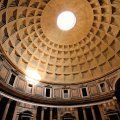PANTHEON
Spectacular for its cylindrical architecture and its age (two thousand years, all the same!), the Pantheon is a must.
The Pantheon was certainly the most admired and studied monument in Rome since antiquity. It symbolizes the "eternal city" in its own right, notably by its age: its walls have been standing for almost two millennia! But also by the superposition of styles and religions in its massive and spectacular architecture which had a determining influence on the Renaissance.
History. It was built by Agrippa in 27 BC, architect and collaborator of Augustus, to whom we also owe the aqueduct irrigating the Trevi Fountain built a few centuries later. The temple whose name means in Greek "of all the gods" was dedicated to Venus and Mars, respectively grandmother and father of the twins Romulus and Remus. In the year 110, the building was destroyed by a fire. Hadrian rebuilt it, as soon as he came to power, between 118 and 125, turning its orientation to 180° and opening in front of it a new temple with arcades, but he left the name of Agrippa on the new pediment. The architectural revolution of this monument was to superimpose on a round building a rectangular pronaos, typical of the facades of the temples. It is this building that is still standing today. Abandoned during the reign of the first Christian emperors and then sacked by the Barbarians, the Pantheon was offered by the Byzantine emperor Phocas to Pope Boniface IV in 609, who then transformed it into a church dedicated to the Virgin Santa Maria ad Martire. The consecration of the church is marked by Catholic legends: it is said that seven demons flew out of the windows, seven as the pagan deities that occupied the place before the pious church. Urban VIII Barberini, a great re-user (to dare a neologism) of ancient monuments, had the bronze plates that lined its ceiling melted down to make the baldachin of Saint Peter's. Finally, Bernini gave it two baroque bell towers, which the Romans had called "donkey ears", and which were destroyed in 1878, after the unification of Italy, when the Pantheon became the burial place of the sovereigns.
Exterior. The structure rests on a concrete ring of volcanic rock mixed with mortar on which rests walls 6 m thick of three different layers of masonry. A mystery that neither the archaeologists, nor the engineers, nor the architects have definitively solved! The cylindrical drum is crossed by bricks and discharge arches to support the most massive dome ever made during Antiquity! The pronaos is made of 16 monolithic granite columns surmounted by a pediment on which one can read the dedication of the temple by Agrippa : M. Agrippa L. F. cos. tertium fecit (Marcus Agrippa, son of Lucius, consul for the third time, had it built). The beams that support the portico were once covered with bronze, stolen by Pope Urban VIII Barberini to make the altar of St. Peter's Basilica and the cannons of Castel Sant'Angelo, engraving a now popular saying "What the Barbarians did not do was done by the Barberini"!
The dome. It has inspired many monuments in the world. It rises to 43.30 m from the ground, and its diameter is 43.30 m. Its interior shape, in 5 rows of 28 caissons, ends with a vast central opening (9 m in diameter) that illuminates the whole. It is said that to build the dome, the interior was filled with earth and gold coins. Once finished, the citizens were invited to clear the earth and keep the coins they found. Near the oculus, the wall that at the base was 6 m thick is now only 2 m thick. Strangely enough, it is said that the rain never enters the Pantheon. At the time, it was in fact the heat of the thousands of candles that formed a warm air current protecting the temple from bad weather. Today, a special kind of rain enters the Pantheon every year on the day of Pentecost. It is a shower of rose petals. It is the firemen who reach the top of the monument to pour these petals which represent, according to the Christian tradition, the descent of the Holy Spirit on the apostles.
The ground. Look down: the marble and the mosaics are original here. The floor is slightly concave to channel potential water flows evacuated through the 22 mysterious holes that are connected to an underground sewer system.
The chapels. The Annunciation painted in the first niche, to the right of the entrance, is by Melozzo Da Forli'. The chapel of St. Joseph is dedicated to the patron saint of the Virtuosi in the Pantheon, an artistic institution to which many famous painters belonged: Raphael, Caravaggio, Brinini, Velasquez, Canova ... It was granted in 1542 to Canon Desiderio de Segni, who had collected earth from Palestine after a pilgrimage to the Holy Land, which is still placed in the ground today. The Pantheon is home to many tombs, including the tomb of Vittorio Emanuele I, the first king of Italy, his son Umberto I, Margherita di Savoia, Hannibal Carracci and the great Raphael. The latter had commissioned Lorenzetto himself, just before his death, to paint the statue of the Virgin Mary with child that adorns his tomb. This was in 1520, and Raphael was only 37 years old.
Did you know? This review was written by our professional authors.
The strengths of this establishment:
Book the Best Activities with Get Your Guide
Members' reviews on PANTHEON
The ratings and reviews below reflect the subjective opinions of members and not the opinion of The Little Witty.





Find unique Stay Offers with our Partners






